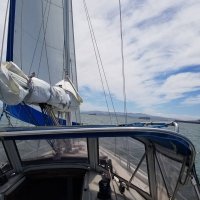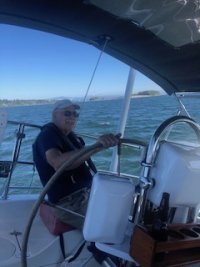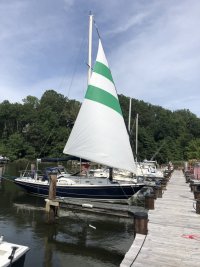Ericsons sail well under jib alone. A happy design outcome.
Ericsons also don't favor too much sail up, and most control issues are result of flying all the laundry in 22 knots and wondering why the boat slews . Do we need a larger rudder? etc.
The easiest measurement of too much sail, I think, is the heel. If the crew on the rail can;t keep the boat at somewhere around 20 degrees heel, performance suffers. Racing, which requires lots of sail area, also requires responsive trimmers and a helmsman who knows how to feather and pick his spots in waves and gusts. To sail an Ericson casually in Force 5, reduce sail.
I have found that in 30 knots plus, only a scrap of roller-furler jib provides a rig balanced such that a vane self-steering gear does fine, even in the usual 10-foot cresting seas offshore. Vanes are quite sensitive to rig balance, so that's a real testament.
I have found that the mainsail is necessary for balance off the wind in any kind of a seaway. Reefed, it provides a steadying counter force to the boat being tossed around and slewed by surfing quartering seas.
We've all noticed the surprisingly good behavior under jib alone (I have a 120 genoa also). One added benefit: if you ever have to sail into the slip, which is quite a project given our crowded marinas, you can douse the main and have complete control under jib alone. That really, really, simplifies a procedure in which luffing is necessary, and for which a big mainsail on a boom is a complication.




